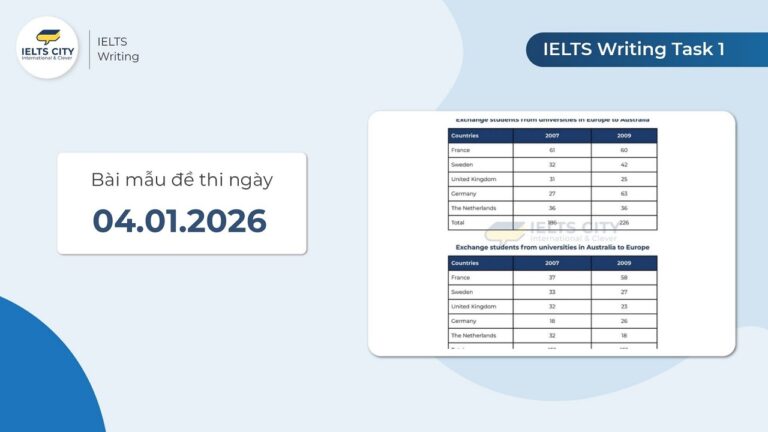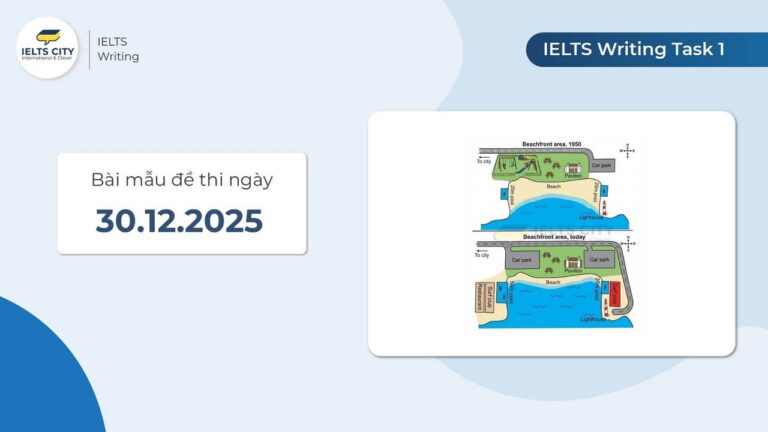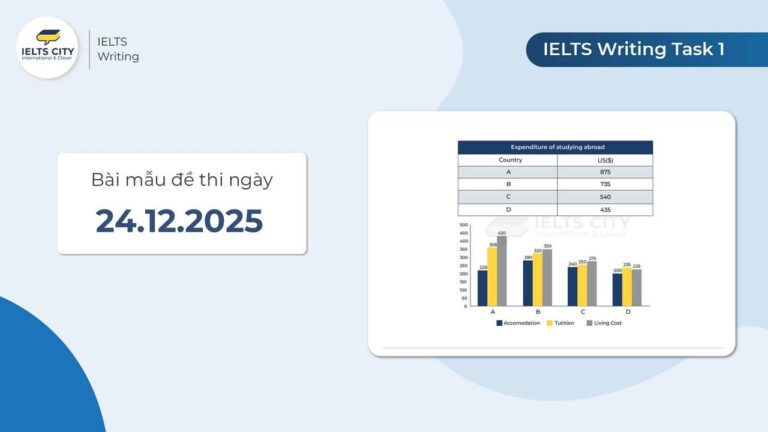Đề thi IELTS Writing Task 2 ngày 02.08.2024 là đề dạng Problem and Solution trong IELTS Writing Task 2 về chủ đề chất lượng cuộc sống đô thị. Trong đề bài này, các bạn sẽ cần phải nêu ra những nguyên nhân về việc chất lượng sống tại các thành phố lớn đang càng ngày tệ đi và nêu ra giải pháp cải thiện vấn đề này. Để có thể xử lý tốt dạng đề này, các bạn hãy cùng IELTS CITY tham khảo bài mẫu 7.5+ phía sau nhé!

Nội dung chính
ToggleĐề thi IELTS Writing Task 2 ngày 02.08.2024
Update: Đề được ra thi lại vào ngày 19.12.2025 (Xem ngay Đề thi IELTS Writing 2025)
In many countries, the quality of life in large cities is becoming worse. What do you think are the causes of this problem? What measures could be taken to solve it?
Dàn ý
Introduction:
- Briefly introduce the topic – the decline in quality of life in large cities. (Paraphrase lại đề bài)
- Thesis statement: This decline is caused by rapid urbanization and environmental degradation, but solutions can be implemented.
Body Paragraph 1:
- Topic sentence: Rapid urbanization is a major cause of the decline in quality of life.
- Supporting points:
- Overcrowding, inadequate housing, strained public services.
- Limited public transportation, longer commute times, traffic congestion, increased stress.
- Shortage of affordable housing, cramped and substandard living conditions.
Body Paragraph 2:
- Topic sentence: The environmental impact of urban sprawl contributes to the problem.
- Supporting points:
- Pollution from traffic, industry, and construction.
- Negative impact on public health (air and water contamination).
- Noise levels and lack of green spaces exacerbate the problem, affecting mental well-being.
Conclusion:
- Restate thesis: The decline in quality of life is a complex problem.
- Summarize main points: Discuss the causes (urbanization and environmental degradation) and propose solutions.
- Call to action: Suggest a comprehensive approach involving sustainable urban planning, environmental protection, and community engagement. Emphasize the importance of proactive measures for a better future.
Hướng dẫn: cách viết IELTS Writing Task 2
Sample Answer 7.5+
The deterioration of quality of life in many large cities across the globe is a pressing issue demanding urgent attention. A confluence of factors, ranging from rapid urbanization to environmental degradation, has contributed to this decline. However, with effective measures and a proactive approach, cities can strive to improve the living standards of their inhabitants.
One of the primary causes of this decline is the rapid pace of urbanization. As populations surge in cities, infrastructure struggles to keep pace, leading to overcrowding, inadequate housing, and strained public services. Limited public transportation systems, for example, result in longer commute times, increased traffic congestion, and higher stress levels. Furthermore, the influx of people often leads to a shortage of affordable housing, forcing residents into cramped and substandard living conditions. Moreover, the environmental impact of urban sprawl cannot be overlooked. Pollution from vehicular traffic, industrial emissions, and construction projects contributes to air and water contamination, negatively impacting public health. Increased noise levels and a lack of green spaces exacerbate the problem, making cities less livable and impacting the mental well-being of residents.
To address this issue, a multifaceted approach is necessary. Firstly, sustainable urban planning is crucial. Cities should focus on developing efficient public transportation networks, promoting walking and cycling, and creating green spaces to improve air quality and provide recreational opportunities. Investing in affordable housing initiatives and implementing stringent building regulations can also help alleviate overcrowding and improve living conditions. Secondly, addressing environmental concerns is paramount. This involves investing in renewable energy sources, reducing carbon emissions, and implementing stricter regulations on industrial pollution. Encouraging the use of eco-friendly transportation options, promoting green building practices, and fostering a culture of environmental awareness among residents are essential steps towards creating a more sustainable urban environment.
In conclusion, the decline in the quality of life in many large cities is a complex problem stemming from rapid urbanization and environmental degradation. To mitigate these challenges, a comprehensive approach encompassing sustainable urban planning, environmental protection, and community engagement is necessary. By taking proactive measures to address these issues, cities can strive to create a more livable and enjoyable environment for their residents, ensuring a better future for all.
Từ vựng
- Confluence (n): Sự kết hợp, sự hội tụ
- Degradation (n): Sự suy thoái, sự suy giảm
- Urban sprawl (n): Sự đô thị hóa lan rộng
- Exacerbate (v): Làm trầm trọng thêm
- Multifaceted (adj): Đa diện, nhiều mặt
- Paramount (adj): Cực kỳ quan trọng
- Mitigate (n): giảm nhẹ, làm dịu
- Comprehensive (adj): Toàn diện, bao quát
- Livable (adj): Dễ sống, dễ chịu
- Proactive (adj): Chủ động, tiên phong
Bản dịch
Sự suy giảm chất lượng cuộc sống trong nhiều thành phố lớn trên toàn cầu là một vấn đề cấp bách đòi hỏi sự chú ý khẩn cấp. Sự kết hợp của nhiều yếu tố, từ đô thị hóa nhanh chóng đến suy thoái môi trường, đã góp phần vào sự suy giảm này. Tuy nhiên, với những biện pháp hiệu quả và một cách tiếp cận chủ động, các thành phố có thể cố gắng cải thiện mức sống của người dân.
Một trong những nguyên nhân chính của sự suy giảm này là tốc độ đô thị hóa nhanh chóng. Khi dân số tăng đột biến trong các thành phố, cơ sở hạ tầng chật vật theo kịp, dẫn đến tình trạng quá tải, thiếu chỗ ở và các dịch vụ công cộng bị căng thẳng. Ví dụ, hệ thống giao thông công cộng hạn chế dẫn đến thời gian di chuyển dài hơn, ùn tắc giao thông gia tăng và mức độ căng thẳng cao hơn. Hơn nữa, sự đổ bộ của người dân thường dẫn đến tình trạng thiếu nhà ở giá rẻ, buộc cư dân phải sống trong những điều kiện chật chội và không đạt chuẩn. Hơn nữa, tác động môi trường của sự đô thị hóa lan rộng không thể bỏ qua. Ô nhiễm từ giao thông xe cộ, khí thải công nghiệp và các dự án xây dựng góp phần gây ô nhiễm không khí và nước, ảnh hưởng tiêu cực đến sức khỏe cộng đồng. Mức độ tiếng ồn tăng lên và thiếu không gian xanh làm trầm trọng thêm vấn đề, khiến các thành phố ít dễ sống hơn và ảnh hưởng đến sức khỏe tinh thần của cư dân.
Để giải quyết vấn đề này, cần có một cách tiếp cận đa diện. Đầu tiên, quy hoạch đô thị bền vững là điều cần thiết. Các thành phố nên tập trung vào việc phát triển mạng lưới giao thông công cộng hiệu quả, khuyến khích đi bộ và đạp xe, và tạo ra các không gian xanh để cải thiện chất lượng không khí và cung cấp cơ hội giải trí. Đầu tư vào các sáng kiến nhà ở giá rẻ và thực hiện các quy định xây dựng nghiêm ngặt cũng có thể giúp giảm bớt tình trạng quá tải và cải thiện điều kiện sống. Thứ hai, giải quyết các vấn đề môi trường là điều tối quan trọng. Điều này bao gồm đầu tư vào các nguồn năng lượng tái tạo, giảm lượng khí thải carbon và thực hiện các quy định nghiêm ngặt hơn về ô nhiễm công nghiệp. Khuyến khích sử dụng các phương tiện giao thông thân thiện với môi trường, thúc đẩy các thực hành xây dựng xanh và nuôi dưỡng một văn hóa nhận thức về môi trường trong số cư dân là những bước cần thiết hướng tới việc tạo ra một môi trường đô thị bền vững hơn.
Kết luận, sự suy giảm chất lượng cuộc sống trong nhiều thành phố lớn là một vấn đề phức tạp bắt nguồn từ đô thị hóa nhanh chóng và suy thoái môi trường. Để giảm nhẹ những thách thức này, cần có một cách tiếp cận toàn diện bao gồm quy hoạch đô thị bền vững, bảo vệ môi trường và sự tham gia của cộng đồng. Bằng cách chủ động giải quyết các vấn đề này, các thành phố có thể cố gắng tạo ra một môi trường dễ sống hơn và thú vị hơn cho cư dân của họ, đảm bảo một tương lai tốt đẹp hơn cho tất cả mọi người.
Cập nhật đề thi IELTS Writing mới nhất:
Cảm ơn các bạn đã theo doi hết bài mẫu đề thi IELTS Writing Task 2 ngày 02.08.2024 band 7.5+ được biên soạn bởi IELTS CITY. Chúc các bạn luyện thi IELTS hiệu quả và sớm đạt Target nhé!





















